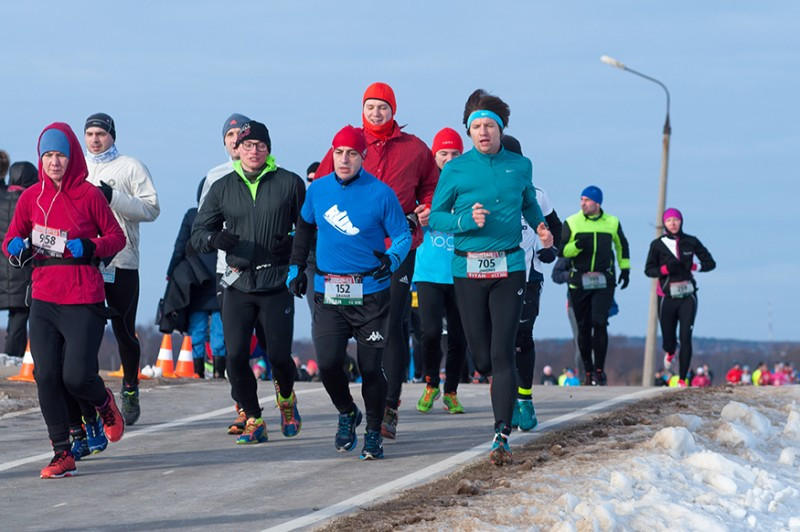Cold weather of the sub-freezing variety can be ideal for snowmen, snow angels and ice sculptures, as well as skiers, skaters and snowboarders, but for traditional fitness workouts and training purposes? Well, why not? Working out in cold weather – for this piece we'll define cold as anything below freezing (0 degrees Centigrade/32 degrees Fahrenheit) – is not only practical and reasonable, it can be invigorating and even burn extra calories, provided you prepare properly and know how to stay warm. Breathing fresh outdoor air can be a boon to your body vs. being cooped up inside the house on a treadmill or even at a gym where the tame of heart labor away on circuit equipment (ehhhh) or indoor track (zzzzz) while (possibly) not know what they're missing when icicles are forming outside. The heat and humidity in the summer can drag you down and tire you faster, but cold weather is invigorating, adventure fitness consultant Sean Burch tells womenshealthmag.com. It stimulates your senses, tunes you in to your surroundings – it makes you feel alive. Oh yeah, sure, but what does he know? Glad you asked. Burch once set a world record in running a marathon . . . at the North Pole. As for that notion of burning more calories in the wintertime, Medicine & Science in Sports & Exercise cites research that found race times are faster in cold weather than in warmer temps, and quicker runs mean burning more calories. Being quick on your feet might not be advisable in winter climes, though: snow and ice can be hazardous for runners as well as for walkers. Even if you are wearing shoes with great support and plenty of tread that can grip slick surfaces (which is advisable), there's nothing like running along a street or roadway with snowbanks piled high on both sides by snowplows, and encountering a vehicle coming toward you slipping and sliding all over the place. There's another angle to using cold weather to your calories-burning advantage, as explained by Michael Joyner, M.D. an endurance athlete and human performance expert. In the cold, you body can regulate its temperature a little better, meaning you can exercise farther or longer, so you can burn more calories, Joyner said, quoted at mensfitness.com. He goes on to say, Any time people can do things to harden themselves mentally, or give themselves confidence, that can definitely be a competitive edge. Cold-weather workouts call for ample prep—mainly protecting yourself from the cold. Think frostbite and hypothermia. Frostbite occurs when temps fall below freezing and is most common in exposed skin, although it can also occur in clothed areas, namely the hands and feet. As with any physical activity that involves much exertion, it is wise to consult with a medical professional before beginning any cold-weather regimen, especially if not acclimated to such extreme wintry conditions. Persons with asthma, heart problems or Raynaud's disease should take particular care, per mayoclinic.org. Noted fitness expert Dr. Joseph Mercola, an experienced runner familiar with below-zero temps, says cold-weather workouts carry an increased risk of heart attacks. When you are in low temperatures outdoors, your cardiovascular system also tends to respond by increasing blood pressure and heart rate, which can promote a heart attack, Mercola says at his website, fitness.mercola.com. Additionally, when you're cold, your airway tends to narrow, making breathing more difficult. Still, with proper care, protection, preparation and consultation (all of which pertain to warm/hot conditions as well), cold-weather workouts can be terrific. Here are some tips:
- Dress in layers. Start with a base of compression clothing that wicks moisture away from your body, top and bottom. Add on looser-fit athletic clothing, and then maybe some sort of windbreaker. Warm, dry socks—maybe two pairs or an extra-heavy pair. Mittens or gloves. A winter hat that covers the ears and the top of the head. Perhaps a scarf that goes across the mouth and nose so you're not breathing in brutally cold air. Later, you can shed some clothing as you start heating up and sweating.
- Wear reflective, light-colored clothing. Remember, it gets dark earlier in the winter months.
- Eat right. A light meal featuring easily digestible proteins and carbohydrates in advance works well.
- Warm up well. Simple stretching won't cut it. Do some jogging or fast walking, indoors, for five minutes or so. You want your joints and muscles loose and ready.
- Stay hydrated. You might not be as thirsty working out in the cold as you would in summertime, but your body still needs replenishment of fluids.
- Plan your route. Know where the conditions are safest – where the plows have been and where to avoid the black ice. Also, think a short, circuitous route near where you start. This is in case you get tired, fall and injure yourself, or get wet and/or cold. Also, be sure to tell someone when you expect to be back, just in case.
- Keep medications handy. Especially good advice for asthmatics or those with other breathing conditions. The cold air can be troublesome.
- Know the signs of frostbite and hypothermia. Frostbite: numbness, loss of feeling, tingling sensation. Hypothermia: intense shivering, slurred speech, loss of coordination, fatigue.
- Sunscreen. Most definitely.

